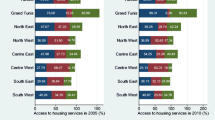Abstract
Building on the current literature that increasingly recognizes inequality of opportunity among children, this paper analyzes to what extent access to basic education and core services is influenced by family and individual background factors in Tunisia. The analysis uses the Human Opportunity Index (HOI) methodology developed recently at the World Bank, and micro data from the National Survey on Households’ Budget, Consumption and Standard of Living (HBCLS) for 2010. The main contribution of the study is its in-depth investigation of the key factors affecting child development in Tunisia. The results reveal large and persistent interregional and intra-regional disparities among children, mainly in pre-secondary school enrollment and access to safe water and sanitation services. Such inequalities of opportunity, obviously shown between inland and littoral regions, are found to be driven mainly by geographic factors and parents” education and wealth. These findings may have important policy implications in term of developing better-targeted interventions aiming to reduce inequality in accessing basic services.


Similar content being viewed by others
Notes
The 2010 National Survey on Households’ Budget, Consumption and Standard of Living can be downloaded from the official website of the Tunisian National Institute of Statistics (www.ins.nat.tn).
The present section merely gives the basic conceptual method for calculating the Human Opportunities Index. For further details and discussion, refer de Barros et al. (2009) which has a more exhaustive explanation of the procedure for computing the second component of the HOI, the Dissimilarity index (D-index), for estimating inequality of opportunity in access to given services. The methodology used in this section hence follows analogous notations as far as possible in order to retain coherence and comparison.
In this study we focus particularly on children as we assume that many of the differences in opportunities are generated during childhood and carried out the whole life. In fact children’s access to basic services or lack thereof will surely determine, in the future, their education, health and labor market outcomes, and hence their income-earning potential as adults. Several longitudinal studies have argues that investments in children from poor and vulnerable families can translate into higher earnings in adulthood, later in life, then helping break the cycle of poverty.
The D-index, as noted in de Barros et al. (2009), is a version of the dissimilarity index (D) broadly used in sociology and applied to dichotomous outcomes.
Because of these difficulties and social exclusion, Sidi Bouzid and Gafsa (located both in the Middle Western region) were the bed of the recent Tunisian revolution.
References
Amara, M. (2009). Concentration et agglomération industrielles dans la métropole de Tunis [Concentration and industrial agglomeration in Tunis metropolis]. Revue d’Economie Régionale et Urbaine, 3, 599–625. doi:10.3917/reru.093.0599.
Amara, M., & Ayadi, M. (2013). The local geographies of welfare in Tunisia: does neighbourhood matter? International Journal of Social Welfare, 22(1), 90–103. doi:10.1111/j.1468-2397.2011.00863.x.
Amara, M., & Ayadi, M. (2014). Local employment growth in the coastal area of Tunisia: spatial filtering approach. Middle East Development Journal, 6(2), 255–284.
Arneson, R. J. (1989). Equality of opportunity for welfare. Philosophical Studies, 56(1), 77–93.
Boutayeb, A., & Helmert, U. (2011). Social inequalities, regional disparities and health inequity in north African countries. International Journal for Equity in Health, 10(1), 1–9.
Cohen, G. A. (1989). On the currency of egalitarian justice. Ethics, 99, 906–944.
de Barros, R. P., Ferreira, F., Vega, J. M., & Chanduvi, J. S. (2009). Measuring inequality of opportunity in Latin America and the Caribbean. World Bank Publications, Washington DC:World Bank.
Dlala, H. (1997). La reconversion compétitive de l’industrie tunisienne: Arrimage à l’Europe et mise à niveau [the competitive conversion of Tunisian industry: lashing Europe and upgrade]. Méditerranée, 87(3), 87–98. doi:10.3406/medit.1997.3010.
Fields, G. S. (2003). Accounting for income inequality and its change: a new method, with application to the distribution of earnings in the United States. Research in Labor Economics, 22(3), 1–38.
Helmers, C., & Patnam, M. (2014). Does the rotten child spoil his companion? Spatial peer effects among children in rural India. Quantitative Economics, 5(1), 67–121.
Jemmali, H., & Amara, M. (2015). Assessing inequality of human opportunities: a new approach for public policy in Tunisia. Applied Research in Quality of Life, 10(2), 343–361.
Roemer, J. E. (1993). A pragmatic theory of responsibility for the egalitarian planner. Philosophy & Public Affairs, 22, 146–166.
Roemer, J. E. (1998). Equality of opportunity. Cambridge: Harvard University Press.
Shorrocks, A. F. (1982). Inequality decomposition by factor components (pp. 193–211). Econometrica: Journal of the Econometric Society.
Son, H. H. (2013). Inequality of human opportunities in developing Asia. Asian Development Review., 30(2), 328.
World Bank. (2006). World development report: equity and development. Washington, DC: The World Bank.
Zhuang, J., Kanbur, R., & Rhee, C. (2014). Rising inequality in Asia and policy implications. ADBI Working Paper (463). Available at: SSRN: http://ssrn.com/abstract=2399298 or doi:10.2139/ssrn.2399298.
Author information
Authors and Affiliations
Corresponding author
Appendix
Appendix
Rights and permissions
About this article
Cite this article
Jemmali, H., Amara, M. On Measuring and Decomposing Inequality of Opportunity among Children: Evidence from Tunisia. Applied Research Quality Life 13, 137–155 (2018). https://doi.org/10.1007/s11482-017-9511-1
Received:
Accepted:
Published:
Issue Date:
DOI: https://doi.org/10.1007/s11482-017-9511-1



